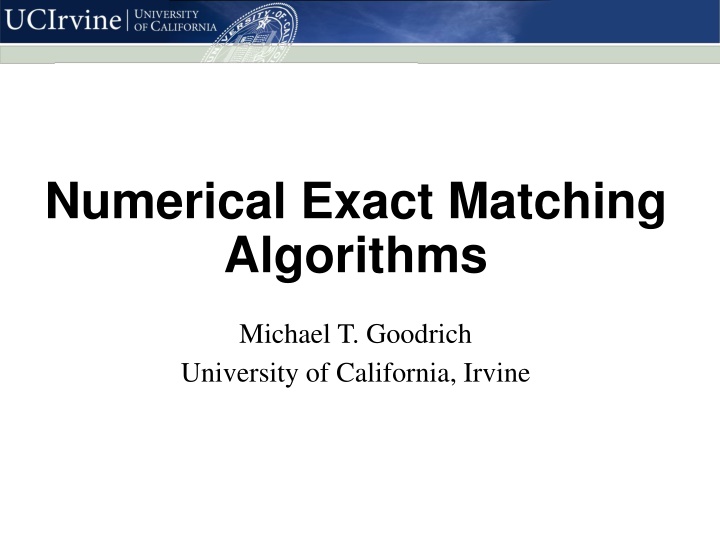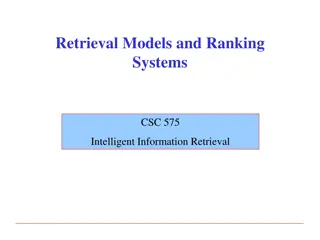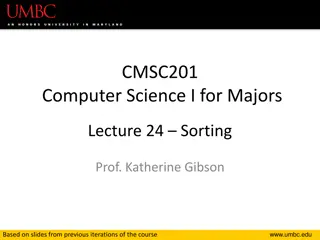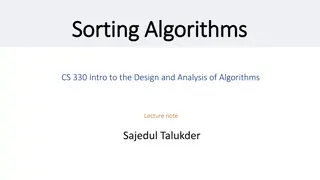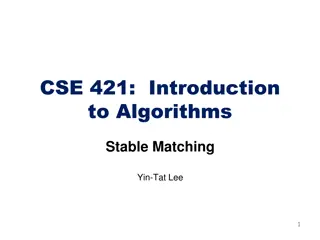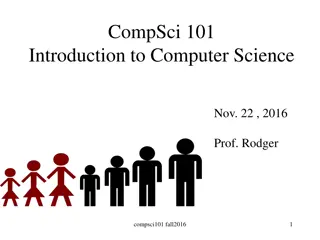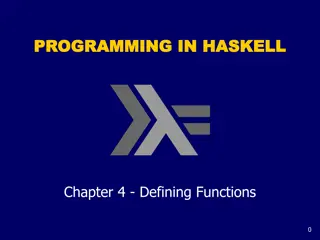Matching Algorithms in Computer Science
Numerical exact matching algorithms like the Rabin-Karp algorithm, which leverages hash values for efficient string searching. Learn about the duality principle and Richard Karp's contributions to the field
Download Presentation

Please find below an Image/Link to download the presentation.
The content on the website is provided AS IS for your information and personal use only. It may not be sold, licensed, or shared on other websites without obtaining consent from the author.If you encounter any issues during the download, it is possible that the publisher has removed the file from their server.
You are allowed to download the files provided on this website for personal or commercial use, subject to the condition that they are used lawfully. All files are the property of their respective owners.
The content on the website is provided AS IS for your information and personal use only. It may not be sold, licensed, or shared on other websites without obtaining consent from the author.
E N D
Presentation Transcript
Numerical Exact Matching Algorithms Michael T. Goodrich University of California, Irvine
The Duality Principle Rather than rely only on comparing characters, numerical matching algorithms take advantage of the fact that characters in a string can also be viewed as (binary) numbers. This concept is often referred to as duality. Image from https://www.javatpoint.com/java-char-to-int
The Rabin-Karp Algorithm The Rabin-Karp string searching algorithm calculates a hash value for the pattern, and for each M-character substring of text to be compared. If the hash values are unequal, the algorithm will calculate the hash value for next M-character sequence. If the hash values are equal, the algorithm will do a Brute Force comparison between the pattern and the M-character sequence at this location (in case of a hash value collision causing a false match). In this way, there is only one comparison per text subsequence, and Brute Force is only needed when hash values match. (Recall that we highlighted Michael Rabin in a previous lecture.)
Richard Karp 1985: Received the Turing Award. 1987: Developed the Rabin-Karp string searching algorithm with Michael Rabin. He is also known for publishing a landmark paper proving 21 problems to be NP-complete. He was also the PhD advisor to Dan Gusfield (author of this course s recommend textbook) and UCI Professor Sandy Irani. Image from https://en.wikipedia.org/wiki/Richard_M._Karp
Rabin-Karp Example Text T = cbabacabb Pattern P = abaca
Rabin-Karp Algorithm (High Level) text is n characters long, patternis m characters long hash_p=hash value of pattern hash_t=hash value of first m letters in text repeat if (hash_p == hash_t) do brute force comparison of pattern and selected section of text hash_t = hash value of next section of text, one character over until (end of text or brute force comparison == true) Running time is O(nm) if we recompute hash_t for each substring of m characters in the text, which is no better than brute-force matching!
Rabin-Karp Rolling Hash Function We can do better by using a rolling hash function, which allows us to compute each hash value from the previous hash value. Consider an m-character sequence as an m-digit number in base b, where b is the number of letters in the alphabet. The text subsequence t[i : i+m-1] is mapped to the number Given x(i) we can compute x(i+1) for the next substring t[i+1 : i+M] in constant time:
Polynomial Rolling Hash Function The original Rabin-Karp algorithm used the a standard polynomial hash function: This requires 2 multiplications and an addition and subtraction to compute each new hash value. Multiplications are generally slower than comparing characters, and these multiplications are in the inner loop of the algorithm. So it may be helpful to have a different hash function.
Bitwise Operators Typical built-in bitwise (bit-parallel) operators, which are faster than multiplication: Image from https://realpython.com/python-bitwise-operators/
Examples Bitwise operations: Cyclic shift by 1 bit: Note the following: X AND X =X X OR X = X X XOR X = 0 Note that bit vectors are indexed from right to left.
Typical Syntax for Cyclic Shift To do a cyclic shift by k bits in C (assumes k < Integer.SIZE): return (bits << k & MASK) | (bits >> (Integer.SIZE - k)) Cyclic shift by 1 bit: MASK: 1 1111110
Cyclic Polynomial Hash Function Let the function s be a cyclic binary rotation (or circular shift): it rotates the bits by 1 to the left, pushing the leftmost bit around to the first position. E.g., s(101)=011, s(101)=011. Define the hash H as follows, where is XOR and h is a random hash function (or lookup table): The new hash value (2 shifts and 2 XORs):
The Rabin-Karp Algorithm Assumes a shiftHash(f, T, i) function for computing a shifted rolling hash value for position i in T given the hash value, f, for position i-1 in T. Let H be the hash of the pattern, i.e., H = h(P) for i 0 to n m do if i = 0 then // initial hash f h(T[0 : m 1]) else f shiftHash(f, T, i) if f == H then // check P against T[i : i + m 1] j 0 while j < m and T[i + j] = Pk[j] do j j + 1 if j = m then return j as a match location
Analysis of the Rabin-Karp Algorithm We are given a test of length n and a pattern of length m. Use a hash function that is random enough so the probability of a false match is at most 1/m. Then the expected running time to find a first match for the pattern (if it exists) is O(n+m).
The Bitap (Shift-Or) Algorithm Described by Ricardo Baeza-Yates and Gaston Gonnet in 1992. Uses bit-parallel operations to implement the approach of the brute-force algorithm more efficiently for cases when the alphabet and pattern are relatively small. Images from https://en.wikipedia.org/wiki/Ricardo_Baeza-Yates, https://en.wikipedia.org/wiki/Gaston_Gonnet
The Bitap (Shift-Or) Algorithm Given a text, T, of length n and a pattern, P, of length m, the bitap (Shift-Or) algorithm performs a type of brute-force search implemented using bitwise operations. If m < word length, w, and the alphabet is relatively small, then the bitap algorithm is fast. The word length, w, for a modern computer is typically 32 or 64, but some processors have specialized registers with word lengths of 128, 256, or even 512. If m is much larger than the word length and/or the alphabet is large, then the bitap algorithm may perform no better than the brute-force algorithm (possibly slower, due to preprocessing steps).
Intuition: Brute-Force Matching Consider a version of the brute-force matching algorithm where we keep doing comparisons even after finding mismatches, and we use an indicator variable, X, that is initially 0 and we set X to 1 if there is ever a mismatch X a b a c a a b a c c a b a c a b a a b b 0 a b a c a b a b a c a b 1 a b a c a b 1 1 a b a c a b 0 a b a c a b 0 a b a c a b
Intuition: Brute-Force Matching Consider a version of the brute-force matching algorithm where we keep doing comparisons even after finding mismatches, and we use an indicator variable, X, that is initially 0 and we set X to 1 if there is ever a mismatch X X a b a c a a b a c c a b a c a b a a b b 1 0 a b a c a b 1 a b a c a b 1 a b a c a b 1 1 1 1 a b a c a b 1 0 a b a c a b 0 0 a b a c a b
Bitap (Shift-Or) State Vector At each stage, j, of the algorithm, we maintain a bit- vector, Xj, such stat Xj[i] = 0 iff there are no mismatches between P[0:i] and T[j-i:j], and otherwise it is 1. So there is a match at j if Xj[m-1] = 0. For each character, a, in the alphabet, we build a comparison vector, C[a], where C[a][i] = 0 iff P[i]=a. C[a] shows the result of all the comparisons that would occur in the brute-force algorithm if the next text character is a.
Comparison Vector Preprocessing Alg. C[a] = 111 1 (of length m) for each a in alphabet For i = 0 to m-1: C[P[i]][i] = 0 Suppose P=abacab and the alphabet is {a,b,c,d}. Then we have the following comparison vectors (recall that bit-vectors are indexed right to left): C[a] = 101010 C[b] = 011101 C[c] = 110111 C[d] = 111111 (the pattern in reverse) b a c a b a
Shift-Or Matching Each comparison can be done with a shift and an OR. X a b a c a a b a c c a b a c a b a a b b 1 a b a c a b 1 a b a c a b a b a c a b 1 1 a b a c a b 1 a b a c a b 0 a b a c a b a b a c a b
Shift-Or Matching Each comparison can be done with a shift and an OR. X a b a c a a b a c c a b a c a b a a b b shift 1 a b a c a b C[b] X 1 0 1 + 1 a b a c a b a b a c a b + 1 1 1 1 1 1 1 1 + a b a c a b 1 1 1 + 1 a b a c a b + 0 0 0 0 a b a c a b a b a c a b + 0 1 1 OR (+)
The Shift-Or Algorithm X = 0; MASK = 111 1 (of length m) For For j = 0 to n-m: X = ((X << 1) & MASK) | C[T[j]] if (X[m-1] == 0) and (j >= m-1) then output output j-m+1 as a match The running time for preprocessing is O([m/w]k+m), where k is the size of the alphabet and [*] is the ceiling function. The running time for the main loop is O(n[m/w]), where w is the word size. Total time is O((n+k)[m/w]+m).
